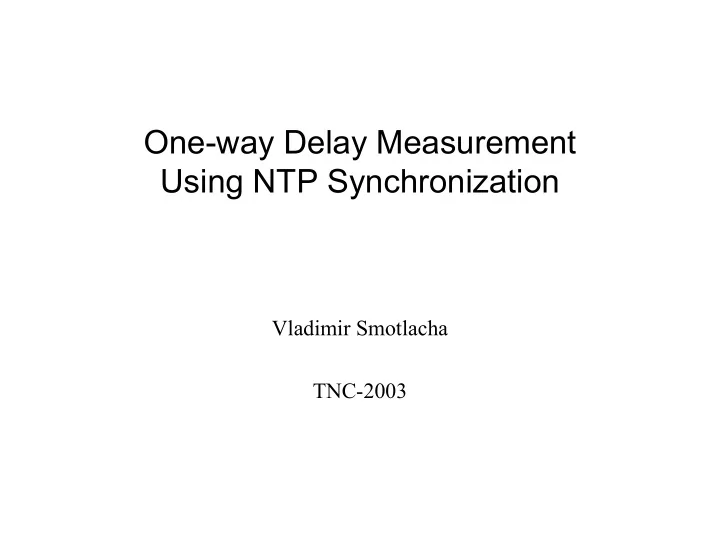

One-way Delay Measurement Using NTP Synchronization Vladimir Smotlacha TNC-2003
One-way Delay • theory (RFC 2679): difference between time of last bit of packet “on-wire” at receiver and first bit of packet “on-wire” at sender – requires specialized HW – reflects OWD at physical layer • practice: OWD = Tr - Ts – Tr ..... timestamp of packet receiving – Ts ..... timestamp of packet sending – OWD measured at application layer – Ts might be included into packet -> only one packet • problem: time synchronization at both sites
Methods of Synchronization • external time source – receiver of time information (GPS, DCF, Loran-C, WWV) – atom clock (cesium, rubidium) – exact, high accurate ( µ s order) – expensive, not scalable, external system installation • synchronization via network (NTP) – NTP server – cheap, scalable – sensitive to network parameters – lower accuracy, difficult to estimate real accuracy
Algorithm of NTP � = (t3 - t0) - (t2 - t1) � 0 = ((t1 - t0) + (t2 - t3)) / 2 � 0 - � /2 � � � � 0 + � /2 • symmetrical delay assumed • uncertainty � half of round-trip delay ntp_meth.png
Sources of NTP Inaccuracy • internal origin – locked loop phenomenon – system reports as known offset - can be used for correction • filterable external origin – jitter of propagation delay – asymmetry in delay due to accidental network load • unfilterable external origin – asymmetry in delay due to long time network load – asymmetry in routing
Configuration for High Accuracy • multiple NTP servers – higher robustness – Selection and Clustering algorithm – accuracy decreased by several milliseconds • one NTP server – vulnerability – high accuracy • default polling interval – self-adjusted: up to 1024 s • explicit polling interval – best accuracy: 16 - 64 s
OWD Measurement Setup I + II
Measured Values • Ts - timestamp of packet sending (from application) • Tr - timestamp of packet receiving (from application) • Os - offset of sender clock (reported by NTP) • Or - offset of receiver clock (reported by NTP) • Ps - exact offset of sender clock (PPS capture log) • Pr - exact offset of receiver clock (PPS capture log)
Calculated Values • Raw one-way delay obtained from CRUDE log OWD_r = Tr - Ts • One-way delay corrected by estimated NTP offsets OWD_n = Tr - Or - (Ts - Os) • Exact one-way delay calculated from GPS time OWD_e = Tr - Pr - (Ts - Ps)
Results (setup I) green - exact OWD red - recalculated OWD red - measured OWD
Results (setup II) green - exact OWD red - recalculated OWD red - measured OWD
Results (setup IIa) green - exact OWD red - recalculated OWD red - measured OWD
OWD Measurement Setup III
Results (setup III) B -> A ( via TELIA) A -> B (via GEANT) red: measured OWD (about 28ms) red: measured OWD (about 28ms) green: exact OWD (about 37 ms) green: exact OWD (about 20 ms)
Conclusions Setup I (local NTP server in each site of measurement) • recalculation of OWD improves accuracy • robust, estimated error in the order of 100 us • assumed low offset between both NTP servers • well suitable for OWD measurement Setup II (one common NTP server) • accuracy depends on NTP server position • estimated error less than 1 ms (symmetric routing) • careful setup of ntpd necessary (differs from default) • suitable for OWD measurement
Conclusions (cont.) Setup III (one NTP server, asymmetric routing ) • stable asymmetry in OWD can not be detected • mean value of measured OWD in both directions is the same • estimated error of measurement is one half of the asymmetry • quite unsuitable for OWD measurement
Suggested NTP configuration • never use multiple NTP servers per box of measurement • careful selection of NTP server – symmetric path between NTP server and site of measurement – low RTT between NTP server and site of measurement – high and long time stability of NTP server – high accuracy of NTP server (stratum-1 or stratum-2) • adjusted polling interval – example: server <NTP server> minpoll 6 maxpoll 6
Thank you
Recommend
More recommend